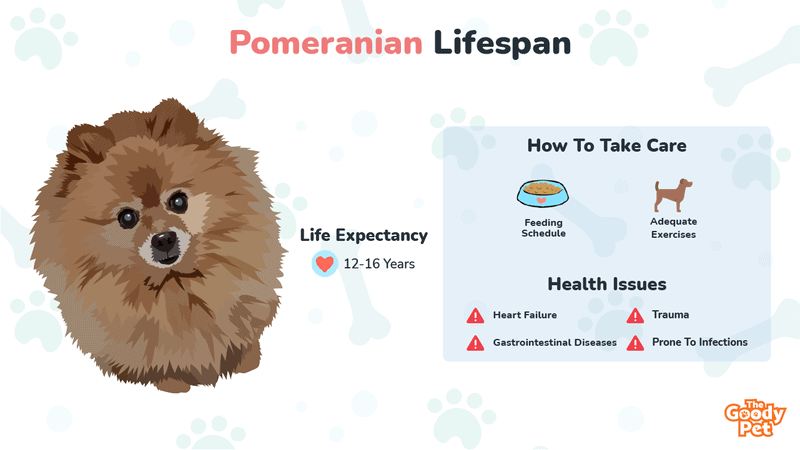While we all wish they can live forever, the fact remains that there’ll come a day when we have to bid goodbye to our precious Pomeranian pooches.
Now, what is the lifespan of a Pomeranian and what are these pooch’s common health issues? The average lifespan of a Pomeranian typically falls between 12 to 16 years. And during its lifespan, the Pomeranian is predisposed to diseases and medical conditions such as obesity, hypothyroidism and patellar luxation, just to mention a few.
Pomeranians are generally expected to live long, and with the necessary care, this pooch will be around for a while. That said, tips on how to take better care of your Pomeranian are outlined in this article. But before we go into that, let’s examine the lifespan of a Pomeranian and some reasons why this pooch may die early.
Why Do Pomeranians Die Early?
Generally, a Pomeranian is expected to live for between 12 to 16 years, with an average lifespan of 14 years.
However, it is quite possible for a Pomeranian to live beyond the speculated age range, and in other cases, some pooches won’t even make it into their teens.
This variation in the lifespan of Pomeranians is down to certain factors, some of which we’ll attempt to explain next.
Genetics
One of the primary factors that governs the lifespan of a Pomeranian dog is the pooch’s genetics and inheritance of traits from its parents.
Consequently, if a Pomeranian inherits any of the serious health conditions that this breed is predisposed to from its parents, you can expect the pooch’s quality of life to be affected, which in turn, results in a considerably shorter lifespan.
Size
The size of a Pomeranian dog also plays a role in determining how long the pooch will live.
That said, miniature Pomeranians typically have shorter lifespans compared to the standard sized Pomeranians. And this is because miniature Pomeranians usually have a weak immune system and are generally more prone to trauma and injuries.
Gender
While this may not count for much, female Pomeranians are generally expected to live for approximately 1.2 years more than their male counterparts.
Quality Of Care Provided
While it is true that the Pomeranian is a hardy dog that is expected to be around for quite some time, failure to provide this pooch with the necessary care and attention can lead to stunted growth and the development of certain medical conditions.
And if the appropriate measures aren’t taken, these medical conditions can considerably shorten the Pomeranian’s lifespan.

What Do Pomeranians Usually Die From?
Some of the leading causes of death in Pomeranians include:
Trauma
One of the major causes of death in Pomeranians and toy dog breeds, in general, is trauma resulting from the pooch being either accidentally stepped on or dropped or hit by moving vehicles.
Several studies have revealed that trauma is responsible for about 13.1% of all adult Pomeranian deaths, and the fatality percentage is even higher for puppy Pomeranians.
The reason for the considerably high number of trauma-related deaths in Pomeranians isn’t unrelated to the fact that these pooches, classified as a toy dog breed, have fragile body structures that break easily under physical stress.
Gastrointestinal Diseases
Another leading cause of death in Pomeranians are gastrointestinal diseases that typically affect the pooch’s stomach and intestine regions.
Approximately 15% of all Pomeranian deaths in a year are related to gastrointestinal issues such as pancreatitis, inflammatory bowel disease, and exocrine pancreatic insufficiency.
Infections
Pomeranians are vulnerable to several kinds of viral, bacterial, and protozoal infections. And these infections account for approximately 9% of Pomeranian deaths in a year.
That said, some of the infections that are mainly responsible for the death of Pomeranians include canine parvovirus, distemper, babesiosis, and leptospirosis.
Similarly, tick diseases and fungal infections such as blastomycosis and histoplasmosis also have a high fatality rate among Pomeranian pooches.
Heart Failure
The Pomeranian is prone to suffering from several heart conditions, but none can be said to be as immediately fatal as when the pooch’s heart fails and stops working completely.
Death resulting from heart failure is typically observed among older Pomeranians, and this occurs due to a weakening of the heart valves, which in turn impairs proper blood-pumping activity.
Common Health Issues
Other common and less fatal medical conditions that a Pomeranian is genetically predisposed to include:
- Dental diseases
- Patellar luxation
- Tracheal collapse
- Hypothyroidism
- Obesity
- Cataracts

How Do I Know If My Pomeranian Is Dying?
Death is an inevitable and painful part of both human and animal life. And a Pomeranian, like all other dogs, will typically exhibit signs that it is nearing the end of its lifespan.
By paying attention to these end-of-life signs, you can provide the appropriate care for your Pomeranian and ensure that its transition through this difficult period goes as smoothly as possible.
That said, some of the signs that are commonly observed when a Pomeranian is dying, and what you can possibly do to make the process easier for the pooch include:
Lethargy
One of the earlier signs displayed by a dying Pomeranian is a loss of interest in activities that once used to get it interested, and the tendency to spend a considerable part of the day sleeping.
Additionally, a lethargic Pomeranian tends to seek solitude and the pooch’s personal hygiene is typically poor, due to the dog’s unwillingness to carry out self-grooming activities.
What You Can Do To Help
- Provide lush blankets to ensure that the Pomeranian sleeps comfortably.
- Assist with grooming and maintenance.
Loss Of Appetite
Another sign commonly exhibited by a dying Pomeranian is a gradual loss of appetite, till the pooch stops eating altogether. In the same vein, a dying Pomeranian may show a preference for eating certain food substances only.
What You Can Do To Help
- Provide smaller meals.
- Take note of what your Pomeranian is interested in eating and feed it to the pooch.
Weight Loss
As a consequence of a dying Pomeranian’s eventual loss of appetite, you can also expect this pooch to suffer a gradual or rapid loss of weight, along with muscle wasting.
What You Can Do To Help
- Consult your vet for the prescription of an appetite stimulant.
Incontinence
As a Pomeranian draws closer to the end of its life, it may experience difficulty controlling its bowel movement, and this results in an increase in the frequency of bathroom accidents.
What You Can Do To Help
- Consider the use of hygienic pads to prevent bathroom accidents.
Movement Difficulties
Due to a dying Pomeranian’s advanced age, the pooch’s joints are significantly weaker, and the dog will find it difficult to get up and move around as a result.
What You Can Do To Help
- Provide skid-proof flooring.
Other Signs That A Pomeranian Is Dying
Apart from those explained above, other signs that a Pomeranian is nearing the end of its life include:
- Decreased body temperature
- Poor body coordination
- Changes in gum color
- Breathing difficulties
- Restlessness
It is important to note that these symptoms may be a sign of a treatable medical condition, and not necessarily death. Hence, upon the manifestation of any of these symptoms, it is recommended that you take your Pomeranian to your vet for a proper diagnosis.

How To Take Better Care Of Your Pomeranian?
Appropriate Diet
When it comes to feeding a Pomeranian, the best food for this pooch is one that is specially formulated for small dog breeds.
The ideal meal for a Pomeranian should contain a relatively high percentage of quality protein sources such as chicken, lamb, or beef, along with good fiber levels, natural omega-3 fatty acids, and wholesome fruits and vegetables.
The nutrients listed above are obtainable in high-quality dry kibble or well-prepared commercial wet food such as the nutritious Pet Plate diet.
The Pet Plate diet is prepared with highly nutritious and healthy ingredients that even the pickiest of dogs won’t be able to resist. And given that the Pomeranian is a mixed breed, you can tackle uncertainties about this pooch’s physical characteristics by making use of Pet Plate’s special meal customization feature.
If you’ll be feeding your Pomeranian with dry kibble, then you must ensure the pieces of kibble are as small as possible to make chewing and swallowing easy for the pooch.
Regardless of what you decide to feed your Pomeranian, you must ensure easy access to clean and fresh water for this pooch at all times. And given that the Pomeranian is predisposed to dental issues, you should invest in dental water additives to promote oral health.
What Foods Are Bad For Pomeranians?
When feeding a Pomeranian, you should avoid food that contains fillers, such as husks, hulls, corn, or mill run.
By-products such as animal necks, intestines, and spleens are also unfit for Pomeranian consumption. And chemical flavoring or synthetic preservatives can cause serious harm to a Pomeranian.
How Much Should You Feed A Pomeranian?
The amount of food that is appropriate for a Pomeranian is a factor of the pooch’s size, with bigger dogs typically needing more food.
To feed your Pomeranian the correct amount of food, you should know what your pooch weighs, correct to within one lb of the actual weight value. And using this as a guide, strictly follow instructions on the food packaging to feed your Pomeranian.
How Many Times Should You Feed A Pomeranian In A Day?
The frequency with which you should feed a Pomeranian in a day is strongly dependent on the pooch’s age.
For a newborn Pomeranian, it is recommended to free-feed the pooch for the first few months of their lives.
However, when the Pomeranian is between three months to a year old, you should cut down the frequency of feeding to three times a day.
And once the Pomeranian clocks a year and above in age, you can feed the pooch either two or three times daily.
Adequate Exercise
Apart from feeding your Pomeranian a nutritious meal, providing the appropriate level of exercise is key to ensuring this pooch’s healthy physical and mental growth.
While it is true that the Pomeranian is a highly energetic dog, this pooch’s small size means it can only partake in a limited amount of exercise per day. And this is provided in the form of two brisk walks per day, for between 20 to 30 minutes each.
In addition to taking the Pomeranian on daily walks, you should also provide various doggie toys and give the pooch time to run around the yard.

Related Questions
What Is The Longest A Pomeranian Has Lived? The record for the longest living Pomeranian belongs to a pooch named Coty that lived for an amazing 21 years, 8 months, and 13 days. Coty was born on June 1, 1994, and passed away on February 14, 2016, having lived a long and fulfilled life, with caring owners.
Is It Better To Have Two Pomeranians? Pomeranians are typical pack animals that thrive extremely well in pairs when raised together; Hence, it may be better to have two Pomeranians instead of one. However, before acquiring a second Pomeranian, you must have the resources needed to take care of both pooches.
Can Pomeranians Swim? Pomeranians are capable swimmers, no thanks to their small sizes and fluffy coats that help them remain afloat in water. However, regardless of your Pomeranian’s ability in the water, you should never let your pooch swim without proper supervision.





